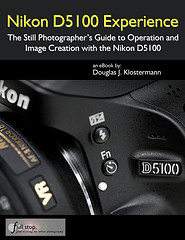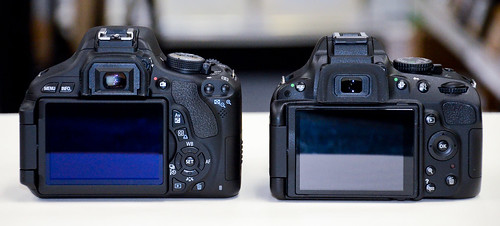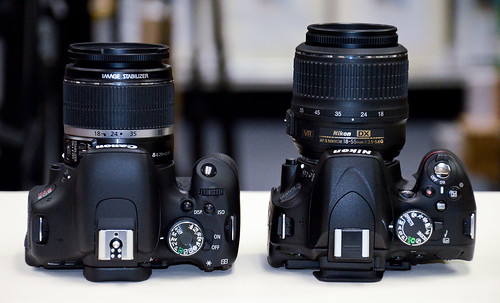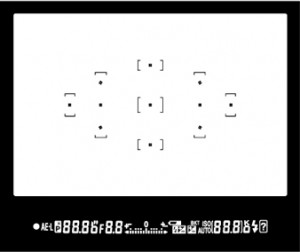Choosing between the Nikon D5100, D7000, D90, and D3100:
A few months ago I wrote a post comparing the Nikon D90 vs D7000 vs D300s. Now that the D5100 is available, I am updating the comparison and include this new model, the highly competent successor to the Nikon D5000.
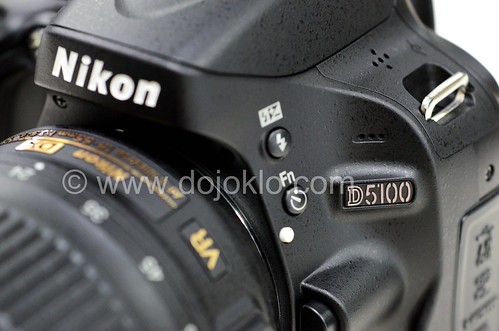
Detail of the Nikon D5100 – photo by author – copyright 2011 – please do not use without permission!
In the Nikon lineup, the D5100 sits just above the D3100, a bit below the aging D90, and a few steps below the highly capable and immensely popular Nikon D7000. You may see some comparison charts that make the cameras appear somewhat (or very) similar at first, but those charts don’t tell the whole story. They can even be deceptive. You really need to take a closer look at not just the specifications, but the features and how they are used in real life, and determine which camera is the right tool for your photography.
The D5100 boasts a 16 megapixel image sensor just like the D7000, shoots 4 frames per second in continuous mode, has HD video capability at 24, 25, and 30 fps, and includes a fully adjustable side-mounted rotating screen more similar to the Canon T3i and 60D than to the bottom mounted limited angle screen on the D5000. It is closer in specifications and price to the Canon T3i than the entry level D3100 and should prove to be an excellent option for new dSLR users plus those experienced enthusiasts wishing to upgrade their D50, D60, or even their D3000 to gain additional megapixels, video, and an improved rear LCD screen.
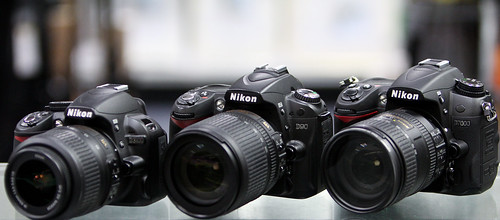
Nikon 3100, D90, D7000 (D5100, not shown, is virtually the same size as the D3100) – photo by author at Newtonville Camera
Below I will spell out some of the differences in specifications and features, as well as what these differences mean and why they may or may not be important to you and your photography. Generally as the cameras increase in price and capability from the entry level model to the enthusiast pro-sumer model they gain more sophisticated autofocus and exposure metering systems, shoot faster (more frames per second) in continuous shooting mode, have more controls on the camera body for changing settings, have sturdier construction, and offer more menu and custom function options. As I always like to point out, when you are trying to determine which camera to purchase or upgrade to, you need to first consider and determine your needs, and then see which camera fills those needs. Not the other way around where you look at the new features and speculate if you really need or will use them. The latest cameras almost always have more impressive features and specifications than the preceding models, and the more expensive, higher-end models will offer more features and options than the lower-end models, but if your needs and shooting style don’t required those additional features and functions then it is possible that you can save some money and be completely happy with a less expensive model.
Sensor and Image Quality: The sensors of the D7000 and D5100 are greatly improved over the older D90 in a couple of ways (it is the same sensor in both cameras). The D7000 and D5100 have 16.2 megapixel sensors, where the D90 has 12.3 megapixels. The relatively new D3100 has a 14.2 MP sensor. This increase in resolution allows for more intrusive editing of the files in Photoshop, the ability to crop a picture and still obtain an image with high enough resolution for printing or display, and allows for larger prints. In addition, the improved sensor results in better performance at high ISO settings and in low light, better dynamic range, tonal range, and color sensitivity. Have a look at dxomark.com to compare the sensors – run your mouse along the red-to-green color bar to the right some of the graphs, such as Dynamic Range, to see how these differences affect images.
Exposure Metering: The D5100, while sharing a similar sensor to the D7000, does not have the same advanced metering system. It shares the less sophisticated 420 pixel RGB metering sensor of the D3100 and offers matrix metering, non-adjustable center-weighted, and spot metering modes. This system may be more than sufficient for many users, especially those not intending to adjust their exposure settings and dig into their menus in reaction to complex lighting situations. But if your shooting demands require more precise exposure metering and control over the size of the areas being metered, you need to consider the D90 or D7000. The 2016 pixel RGB metering sensor of the D7000 is also improved compared to the D90, and will result in more accurate metering performance of straightforward and complex lighting scenes and situations. Both these cameras offer matrix metering, center-weighted, and spot metering modes. With center-weighted metering on the D90, you can select the size of the center-weighted area to be a 6, 8, or 10mm center circle, and the D7000 adds a 13mm circle option to those. (If you don’t understand what this means or why you may need it, you probably don’t need it!)
Autofocus: The autofocus systems of the D3100, D5100, and D90 all have 11 autofocus (AF) points with the center one being a more accurate cross-type. These AF systems may be more than sufficient for most users, and they can successfully track moving objects in the frame such as athletes, performers, or animals. However, if you specialize in sports, action, wildlife, or bird photography, you are going to want to consider the much more sophisticated, accurate, and customizable AF system of the D7000. The D7000 boasts a significantly improved AF system of 39 AF points with 9 of them (in the center) being cross type. The AF system of the D7000 allows for you to use these points in various ways including automatic AF point selection, single point AF, and dynamic area AF using your choice of 9 points, 21 points, all points, or all points with 3D-tracking. With the D7000 you can also use a custom function to limit the AF system to 11 points, which may be more manageable for someone who wishes to manually select their AF points. (Have a look at this article for an in-depth explanation of the D7000 AF system and its capabilities)
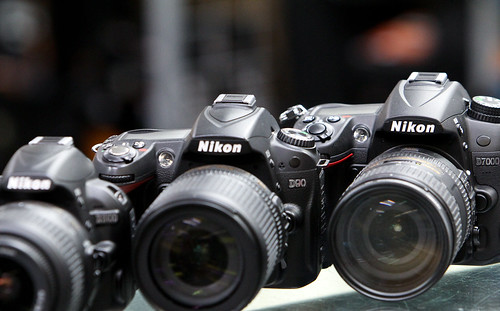
Nikon 3100, D90, D7000 (D5100, not shown, is virtually the same size as the D3100) – photo by author at Newtonville Camera
Body, Construction and Size/ Weight: The D5100 is just slightly larger and a tiny bit heavier than the D3100, both weighing just over one pound. Both have plastic bodies and more limited buttons and controls that the higher end models. The D90 and D7000 appear very similar at first glance, but the plastic body of the D90 has been upgraded to the partially magnesium alloy body (top and rear) of the D7000. This adds slightly to the weight: 1.5 lbs for the D90 vs. 1.7 lbs for the D7000. The sturdier construction of the D7000 versus the D90 – including its nicer rubber gripping surfaces – creates the impression and feel of a more professional body. The D7000 also has weather sealing at the memory card and battery doors.
The higher end D7000 includes not only the 3″ rear LCD screen but also a top LCD panel for viewing and changing your settings. This is essential for photographers who are constantly changing their settings to deal with various shooting situations. It is worth noting that the magnesium alloy body of the D7000 does not fully extend around the front, and thus the area surrounding the lens mount is plastic. See this image of a D7000 skeleton next to one of a 7D for details. For most users, including even those using the camera daily or in rugged travel situations, the non-magnesium construction of the D5100 should be far more than good enough, strong enough, and durable enough.
Please know that the size and weight of these bodies is a result of their build, features, and capabilities. Those are the criteria that should be compared first, not the resulting size and weight. (Also be sure to read this post of Why How it “Feels” is not a valid Criterion for Choosing an dSLR.)
ISO: As mentioned in the Sensor and Image Quality section above, the high ISO performance of the D7000 is greatly improved over the D90. The tests at dxomark.com tell this story, along with the fact that the native ISO range of the D7000 is 100-6400 expandable up to 25,600. The D5100 shares these specifications, and should offer similar results. The D3100 has a native ISO range of 100-3200 expandable to 12800, and the range of the D90 is 200-3200. This means that with the D7000 and D5100 you can use higher ISO settings when required, such as in low light situations, and not have as much difficulty with digital noise, particularly in the shadow areas of images.
Controls: As with construction, the buttons and controls vary with these cameras. The D3100 and D5100 offer limited, basic controls on the exterior of the camera. However you can use the rear LCD screen to quickly change many settings, or else go into the menus. The D7000 offers an extensive array of controls on the camera body, allowing one to quickly change a large number of settings as they work, including focus mode and focus area settings, shooting mode, and exposure mode. The controls of the D7000 are similar to the D90 with some changes including the addition of the shooting mode ring under the mode dial (to change from single shot to high speed continuous to self timer, etc.), and the live-view switch with movie record button inside it. The top AF button of the D90 is incorporated into the AF switch and button at the base of the lens on the D7000. The D7000 also offers more white balance options than the other cameras, plus 2 customizable user settings (U1, U2) on the mode dial, and you can assign functions of your choice to buttons such as the Fn Button.
Menus and Custom Settings: These allow for greater control over customizing how the camera functions. The D5100 has less Menu and Custom Settings options than the D90 and the highly customizable D7000, and more than the D3100 (which offers no custom settings). These settings enable you to customize the operation, function, and controls to work how you want them to, including things like exposure increments, Live View options, tweaking how the autofocus system operates, setting more precise white balance settings, and customizing which button does what. There are ebooks such as my Nikon D7000 Experience and Nikon D5100 Experience which walk you through all of the Menu settings and Custom Settings so that you can set up your camera to work best for how you photograph, and also begin to learn to master all the advanced features, settings, and controls of these powerful dSLR cameras.
Brief commercial interruption: I would like to mention that I have written an eBook user’s guide for the Nikon D7000, and one for the Nikon D5100. After spending so much time studying, experimenting, writing about, comparing, and discussing these cameras, I decided to put some that knowledge into eBook form! The guides covers all the Shooting, Setup, and Playback Menu settings and every Custom Function setting – with recommended settings – plus discussions of how, when, and why to use the cameras’ settings and features, (metering modes, aperture and shutter priority modes, advanced autofocus use, focus lock, exposure lock, and more) for everyday and travel use, to help you take better photos.
Click HERE to learn more about Nikon D7000 Experience – and to view a preview, or purchase it!
And see HERE to learn about, preview, and purchase my ebook guide Nikon D5100 Experience.
Wireless Flash: The D7000 includes the feature of advanced wireless lighting using the built in flash as a commander for off-camera Nikon Speedlights. However, the D5100 and D3100 do not have this capability. With the D7000, you can set up one or more Speedlights in remote mode, then trigger them wirelessly with the built in flash of the camera.
Viewfinder: The D5100 has a pentamirror viewfinder with approximately 95% coverage of the actual resulting image, just like the D3100. The higher quality pentaprism viewfinder of the D90 gives 96% coverage of the actual resulting image, while the D7000 has a larger, brighter pentaprism viewfinder with 100% coverage. While in-and-of-itself, a 95% viewfinder works just fine, when you compare it side-by-side with the large, clear view of the D7000, you can see and understand the advantages of a clearer view of your entire scene with a 100% view, pentaprism viewfinder.
Processor: The Nikon D5100 and D3100 use the fast Expeed 2 image processor just like the D7000. This allows for more video options including full 1080p HD at 24fps, overall faster processing of stills and video files, and the ability to maintain fast continuous speed shooting for numerous frames. The D90 has the older Nikon Expeed processor, which is also fast enough to handle its processing needs.
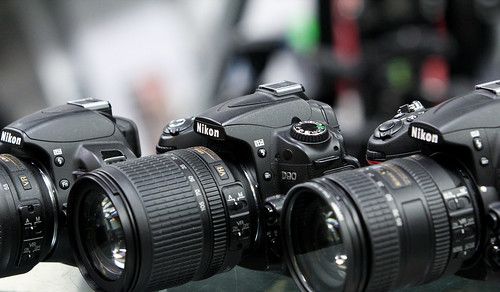
Nikon 3100, D90, D7000 (D5100, not shown, is virtually the same size as the D3100) – photo by author at Newtonville Camera
Continuous Shooting Speed: As you work your way up the Nikon dSLR line-up the cameras’ continuous shooting speed and maximum shots at that rate increases. The D3100 shoots 3 frames per second (fps) in continuous shooting mode, the D5100 shoots 4 fps, and the D7000 shoots 6 fps for up to 100 shots. The D90 can shoot 4.5 fps up to 100 images. If you often capture action and really need the higher frame rate, such as for sports, action, or wildlife shooting, you are going to have to seriously consider the D7000 over the other cameras. Paired with its advanced autofocus system, this fast frame rate can sharply capture moving objects is all types of situations. A nice feature of the D7000 is that you can adjust the low speed continuous mode to shoot anywhere from 1 to 5 fps, using the custom settings.
Memory Card: The D5100, D3100, and D90 all use a single SD memory card. The D7000 accepts 2 SD cards, where the second card can be used in a variety of ways: overflow when the first card fills up, JPEG on one / RAW on the other, or mirrored backup of the first card. The second card can come in handy as well if one is shooting video files, and one card can be designated for stills and the other video.
Battery and Battery Grip: The D5100 and D3100 both use the EN-EL14 battery, and the D7000 uses the new, higher capacity EN-EL15 battery, which will last for over 1000 shots. The D7000 accepts the optional MB-D11 battery pack/ vertical grip which is constructed of magnesium alloy. The D90 uses the EN-EL3e battery and its optional battery pack/ vertical grip is the MB-D80. The D5100 and D3100 don’t accept a battery grip. The battery pack /grip is handy for providing the ability to use a second battery and thus prolonging shooting time, and also creates a larger camera body which some users find more comfortable, especially when shooting in portrait orientation.
Full HD video: The D5100 shoots 1080p and 720p video at 24, 25, and 30 fps. The D3100 shoots 1080p at 24 fps and 720p at 24, 25, and 30 fps. The D7000 also shoots 1080p at 24 fps only and 720p at 24, 25, and 30 fps, up to 20 minutes with full-time continuous autofocus. The D90 offers 720p video at 24 fps, with a 5 minute shooting time.
Ease of Operation: While beginners may find all the buttons, controls, and menus of any dSLR difficult and confusing at first, the menus and controls of the D5100 and D3100 are pretty basic and simple to learn for a dedicated user. The additional controls and menus of the D7000 and D90 are all quite intelligently designed and will become intuitive and straightforward for the more advanced user once they are learned and understood. Again, have a look at helpful guides such as my Nikon D7000 Experience and Nikon D5100 Experience to begin to learn to master all the advanced features, settings, and controls of these powerful dSLR cameras.
If you are interested in comparing the D5100 or D7000 to the comparable Canon models, have a look at these articles:
Nikon D7000 vs. Canon 60D (and 7D)
Purchasing these cameras: If you plan to buy any of these cameras, accessories, or anything else through Amazon.com or Amazon.com UK, I would appreciate it if you use my referral links. Your price will be the same, and they will give me a little something for referring you, which will help support my blog. Thanks! In the USA, use the links throughout this post or use this referral link to Amazon. And for those of you across the pond, click here for my referral link to Amazon UK. Thank you for supporting my efforts!
See the Nikon D5100 with 18-55mm Lens on Amazon $899
See the Nikon D5100 – Body Only on Amazon $799
See the Nikon D7000 – Body Only on Amazon $1199
See the Nikon D7000 and 18-105mm Lens on Amazon $1499
See the Nikon D3100 with 18-55mm Lens on Amazon
See the D90 on Amazon $739 body only or $1049 with 18-105mm lens
Purchasing from the UK? Use my Amazon UK referral link here. If you wish to purchase from B&H Photo, Adorama, or direct from Canon, please click on their logos on the left side of this page or on the Gear page. Thanks!
Accessories and Books: Now that you are on your way to deciding on a camera, you should also start looking into photography gear, accessories, and books. Check out these links, dSLR Photography Gear, Accessories, and Books, which discusses essential gear plus accessories specific to Nikon cameras; Equipment for Travel Photography, which discusses useful and practical photo accessories and equipment for both everyday and travel photography.
And to sum it all up, here is a brief, mostly serious synopsis to help you make the camera decision:
Get a Nikon D3100 if you are new to photography or to digital SLR photography and don’t want to spend a lot of money on a camera because you might only be using it on Auto mode, or if you don’t plan to really “get into” photography beyond taking better photos than you are able to with your compact point-and-shoot and having the ability to use various lenses. The D3100 is a camera one could outgrow in time if they work at their photography and advance. See the Nikon D3100 on Amazon.
Get a Nikon D5100 if you are new to photography or to digital SLR photography and think you will want to experiment beyond Auto mode, or want to upgrade from an older entry level model because you want higher image quality and more mega-pixels, or HD video. If you have been happy with the features and controls of your previous basic dSLR camera and have not discovered the need, in your use of it, for any specific additional advanced features, there may be no need to look beyond the D5100. The D5100 is a camera one can grow with, but it is also one a user could outgrow if they are dedicated to their photography and start to require more advanced capabilities. See the Nikon D5100 on Amazon.
Get a Nikon D90 if you have outgrown the capabilities of an older Nikon like a D3000 or D40 through D60 due to your greater experience and more demanding shooting needs which require more direct or sophisticated controls and customization options. Or you have been pretty pleased with your D70 or D80 and its features but wish to upgrade for the increased image quality and mega pixels (or HD video). And/ or you need a more rugged camera for your frequent and demanding shooting and off-the-beaten-path traveling needs. Or if you need the increased 4.5 frames per second continuous rate to shoot sports or action. If you typically shoot on Auto or Program mode, you may not need a D90. If you do not manually select your own focus point and have never used exposure compensation you may not need a D90. If you have never used the AE-Lock [AE-L] button to lock exposure you may not need a D90. If you don’t understand the relationship between aperture, shutter speed and ISO and don’t intend to learn more about it, you may not need a D90. Or unless you plan to dedicate yourself to learning this camera and the principles of SLR photography and grow into this more advanced camera, consider saving the money or using it towards a better lens. The D90 is a camera one would not outgrow as it has advanced features and capabilities, but its drawback is that it is now outdated. See the Nikon D90 on Amazon.
Get a Nikon D7000 if you have extensive experience with a D3000, D40 through 60, or D70 through D90 camera, and you know and understand most of the D7000’s advanced features and customization options, and you specifically need some of them for your demanding shooting needs. If you haven’t passed the above “criteria” for a D90, you probably don’t need a D7000. If you have never used A aperture priority mode or M manual mode, you probably don’t need a D7000. If you have never used autofocus tracking settings to track a moving subject across your frame and worried how an interfering object would affect your focus you might not need a D7000. If you have never used spot metering to determine a critical exposure level you may not need a D7000. Or unless you plan to dedicate yourself to learning this camera and the principles of SLR photography and grow into this very advanced camera, consider saving the money or using it towards a better lens. However, if you often need to take 100 consecutive photos at the rate of 6 frames per second, you do need the D7000. Immediately. Even if you just sometimes need that. Totally worth it. That’s 16.67 seconds of continuous shooting. Who doesn’t need that? You’d make Eadweard Muybridge proud. The D7000 is not a camera one would outgrow for a long time, and in fact will meet many of the demands of a professional. See the Nikon D7000 on Amazon.
(Please note, the D3100, D5100, D90, and D7000 all have these features and capabilities I just listed: manually selected focus points, exposure compensation, AE-Lock, auto-focus tracking, and spot metering. I’m just using them as a determination of your experience level and needs.)
Was this post helpful? Please let others know about it by clicking the Facebook, Twitter, or Google+ sharing buttons below, or linking to it from your blog or website, or mentioning it on a forum. Thanks! Want to help support this blog with no cost or effort? Simply click on the Amazon and B&H Photo logos on the left side of this page to go to those sites and make your purchases. They will then give me a little referral bonus!



